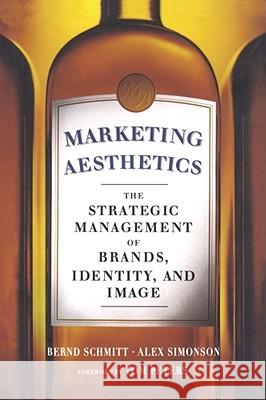Marketing Aesthetics » książka
Marketing Aesthetics
ISBN-13: 9781439172926 / Angielski / Miękka / 2009 / 368 str.
There is no way to mistake the ubiquitous trademarked Coca-Cola bottle, or the stylish ads for Absolut Vodka with any of their competitors. How have these companies created this irresistible appeal for their brands? How have they sustained a competitive edge through aesthetics?
Bernd Schmitt and Alex Simonson, two leading experts in the emerging field of identity management, offer clear guidelines for harnessing a company's total aesthetic output -- its "look and feel" -- to provide a vital competitive advantage. Going beyond standard traditional approaches on branding, this fascinating book is the first to combine branding, identity, and image and to show how aesthetics can be managed through logos, brochures, packages, and advertisements, as well as sounds, scents, and lighting, to sell "the memorable experience." The authors explore what makes a corporate or brand identity irresistible, what styles and themes are crucial for different contexts, and what meanings certain visual symbols convey. Any person in any organization in any industry can benefit from employing the tools of "marketing aesthetics." Schmitt and Simonson describe how a firm can use these tools strategically to create a variety of sensory experiences that will (1) ensure customer satisfaction and loyalty; (2) sustain lasting customer impressions about a brand's or organization's special personality; (3) permit premium pricing; (4) provide legal "trade dress" protection from competitive attacks; (5) lower costs and raise productivity; and (6) most importantly, create irresistible appeal. The authors show how to manage identity globally and how to develop aesthetically pleasing retail spaces and environments. They also address the newly emergent topic of how to manage corporate and brand identity on the Internet. Supporting their thesis with numerous real-world success stories such as Absolut Vodka, Nike, the Gap, Cathay Pacific Airlines, Starbucks, the New Beetle Website, and Lego, the authors explain how actual companies have developed, refined, and maintained distinct corporate identities that set them apart from competitors.There is no way to mistake the ubiquitous trademarked Coca-Cola bottle, or the stylish ads for Absolut Vodka with any of their competitors. How have these companies created this irresistible appeal for their brands? How have they sustained a competitive edge through aesthetics?Bernd Schmitt and Alex Simonson, two leading experts in the emerging field of identity management, offer clear guidelines for harnessing a companys total aesthetic output -- its "look and feel" -- to provide a vital competitive advantage. Going beyond standard traditional approaches on branding, this fascinating book is the first to combine branding, identity, and image and to show how aesthetics can be managed through logos, brochures, packages, and advertisements, as well as sounds, scents, and lighting, to sell "the memorable experience." The authors explore what makes a corporate or brand identity irresistible, what styles and themes are crucial for different contexts, and what meanings certain visual symbols convey. Any person in any organization in any industry can benefit from employing the tools of "marketing aesthetics."Schmitt and Simonson describe how a firm can use these tools strategically to create a variety of sensory experiences that will (1) ensure customer satisfaction and loyalty; (2) sustain lasting customer impressions about a brands or organizations special personality; (3) permit premium pricing; (4) provide legal "trade dress" protection from competitive attacks; (5) lower costs and raise productivity; and (6) most importantly, create irresistible appeal. The authors show how to manage identity globally and how to develop aesthetically pleasing retail spaces and environments. They also address the newly emergent topic of how to manage corporate and brand identity on the Internet. Supporting their thesis with numerous real-world success stories such as Absolut Vodka, Nike, the Gap, Cathay Pacific Airlines, Starbucks, the New Beetle Website, and Lego, the authors explain how actual companies have developed, refined, and maintained distinct corporate identities that set them apart from competitors.











